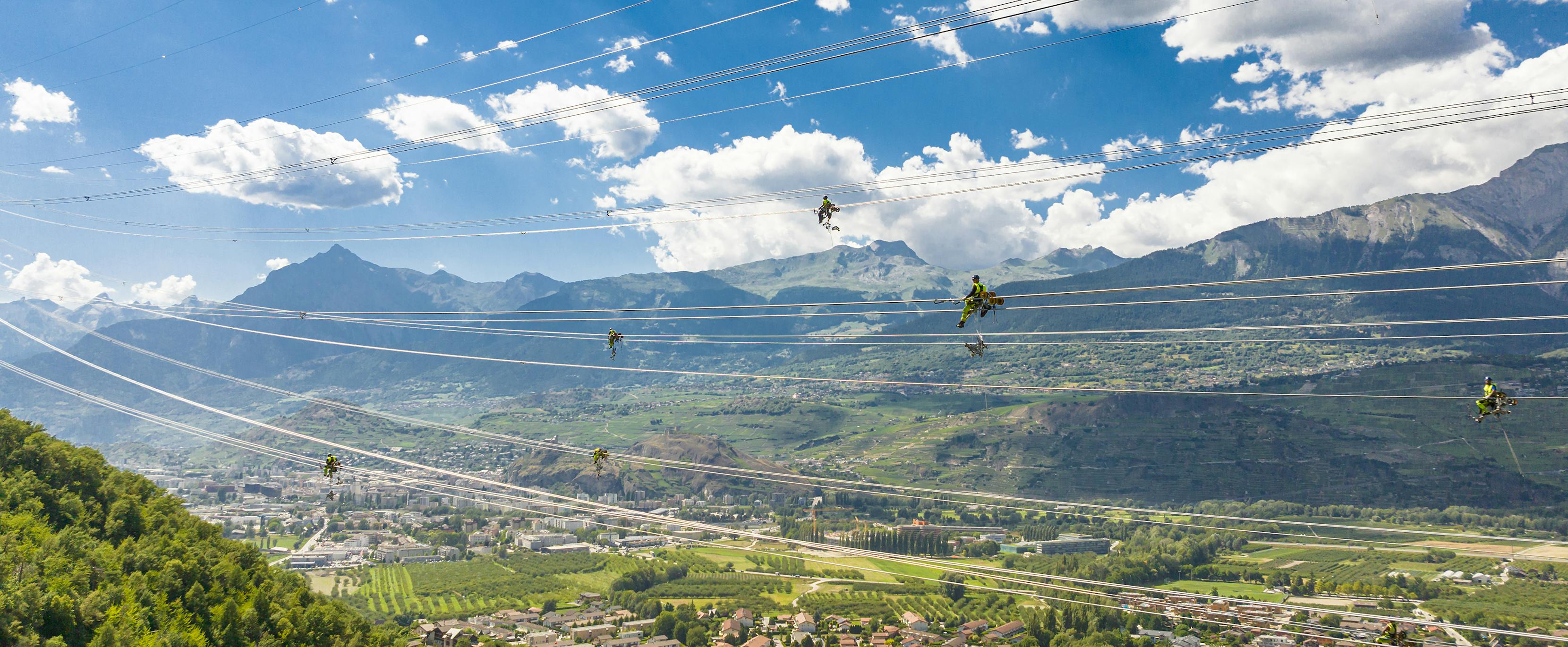Since 30 September 2022, electricity has been flowing along the new Chamoson – Chippis extra-high-voltage line. This has eliminated a major congestion point in the transmission of energy produced by the hydroelectric power plants in the Valais. Therefor it will benefit security of supply in the canton of Valais and in Switzerland as a whole. In addition, a schedule is currently being drawn up for the dismantling of the 90 km of existing overhead lines that will disappear on the Rhône plain.
After 32 years of studies and procedures and four years of construction, the new Chamoson – Chippis overhead line is in operation. Built on a new route of around 30 km on the left bank of the Rhône, its 77 pylons support two 380 kV lines and one 220 kV line belonging to Swissgrid, two 132 kV lines belonging to SBB and one 65 kV line belonging to Valgrid. This grouping of power lines will allow the dismantling of several existing power lines to begin in 2023, as the main compensatory measure associated with the construction of the new line. By 2027, 90 km of overhead lines and 322 pylons will have disappeared on the Rhône plain.
Security of supply
The new Chamoson – Chippis line will help to ensure security of supply in the canton of Valais and in Switzerland as a whole. This new overhead line is a flagship project for Swissgrid’s «Strategic Grid 2025». It will increase the capacity for transporting electrical energy produced by the hydroelectric power plants in the Valais to the country’s major consumption centres.
Furthermore, a 380/220 kV transformer station is now in place at the Chippis substation, where electricity is converted to a lower voltage and fed into the regional distribution system, thus improving the security of the canton’s electricity supply.
The extra-high-voltage grid, a pillar of the Energy Strategy 2050
In order to ensure a reliable flow of electricity between the Valais, which is the largest hydroelectricity-producing canton, and the country’s consumption centres, it is essential to eliminate congestion in the grid by modernising it and increasing transmission capacity. The new Chamoson – Chippis line is a milestone: a major congestion point that limited energy transport has been eliminated. The power plants in the Valais will now have more transmission capacity available to take advantage of their electricity production, as hydroelectricity plays a crucial role in the energy transition. The commissioning of the Chamoson – Chippis line is only a first step, however, as several projects for the construction and adaptation of extra-high-voltage lines are underway in the Valais.
The electricity transmission grid is the key to a sustainable energy future. It must be reliable and stable to operate in order to play its role as a pillar of the Confederation’s Energy Strategy 2050, which includes measures for the development of national hydroelectric production.
Swissgrid is carrying out several projects for the expansion of the extra-high-voltage grid in the Valais
- Bickigen – Chippis extra-high-voltage overhead line (Gemmi line):
project to increase the voltage from 220 to 380 kV on the existing route. The Swiss Federal Office of Energy approved the project in February 2022. A case is currently pending before the Federal Administrative Court. - Mörel – Ulrichen 380 kV overhead line:
project to build a new line. The Ernen – Ulrichen section has been in operation since 2019. The Ernen – Mörel section is in the final stages of construction and will be put into service in 2023. - Chippis – Mörel 380 kV line:
project to build a new line. A building permit for the project has been applied for from the Swiss Federal Office of Energy. - Chippis – Stalden 220 kV line:
enhancement of the line with the addition of a second 220 kV line on the route. The project has been approved by the relevant federal authorities and work is about to begin. - Innertkirchen – Ulrichen 380 kV line:
construction of a new line. The project is currently undergoing the sectoral plan procedure. The project monitoring group set up by the Swiss Federal Office of Energy is currently evaluating the various alternative corridors.
